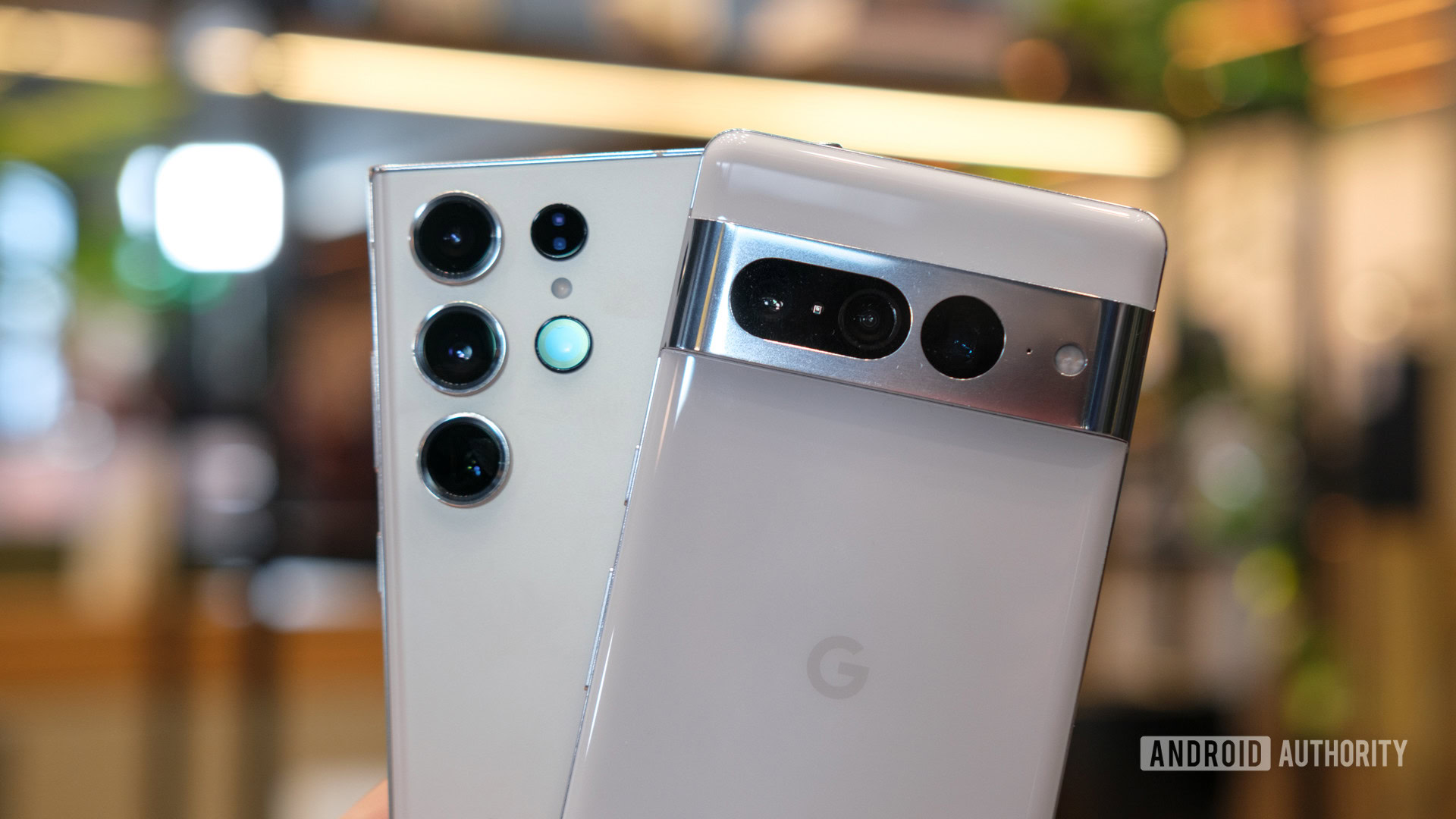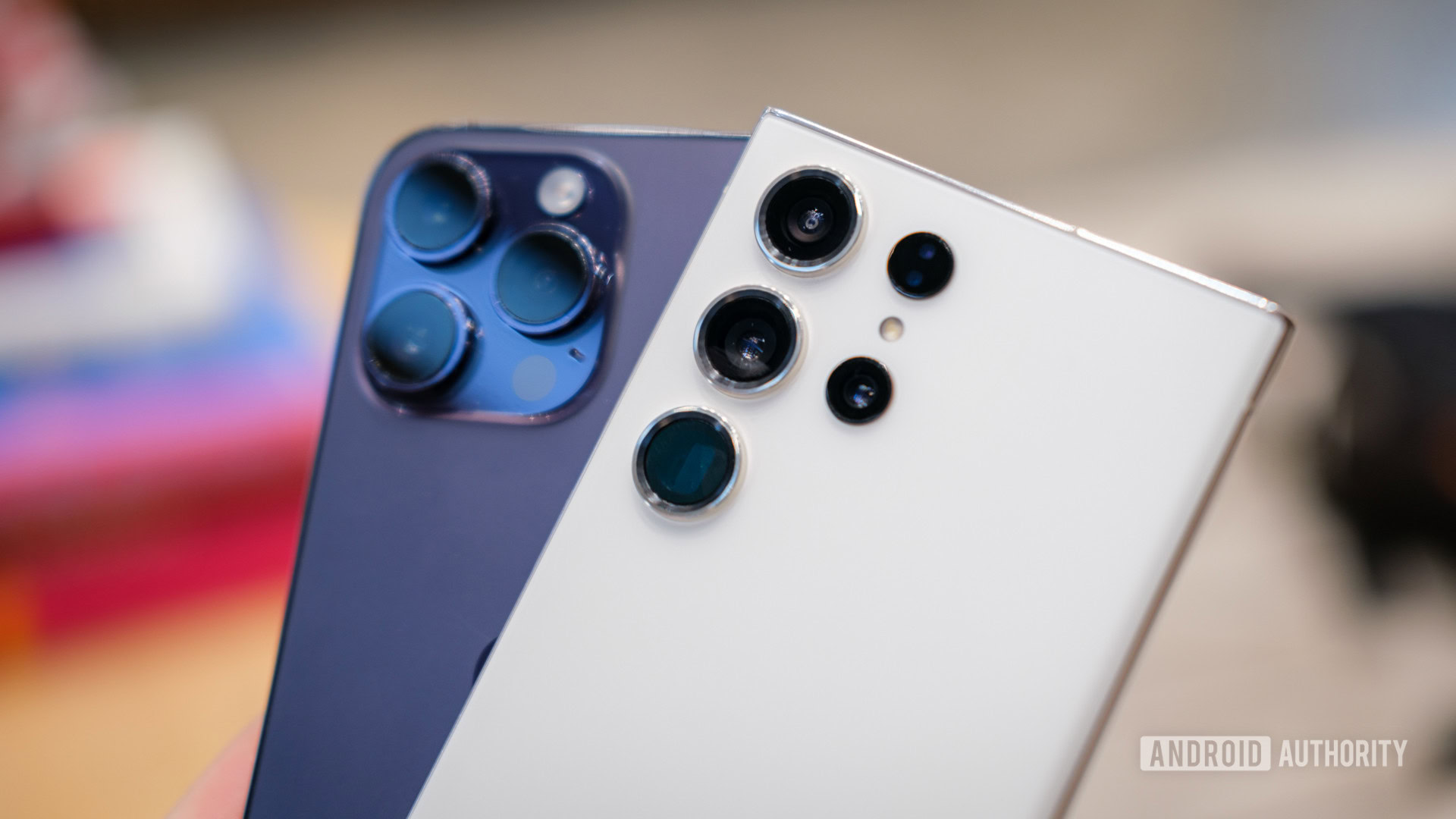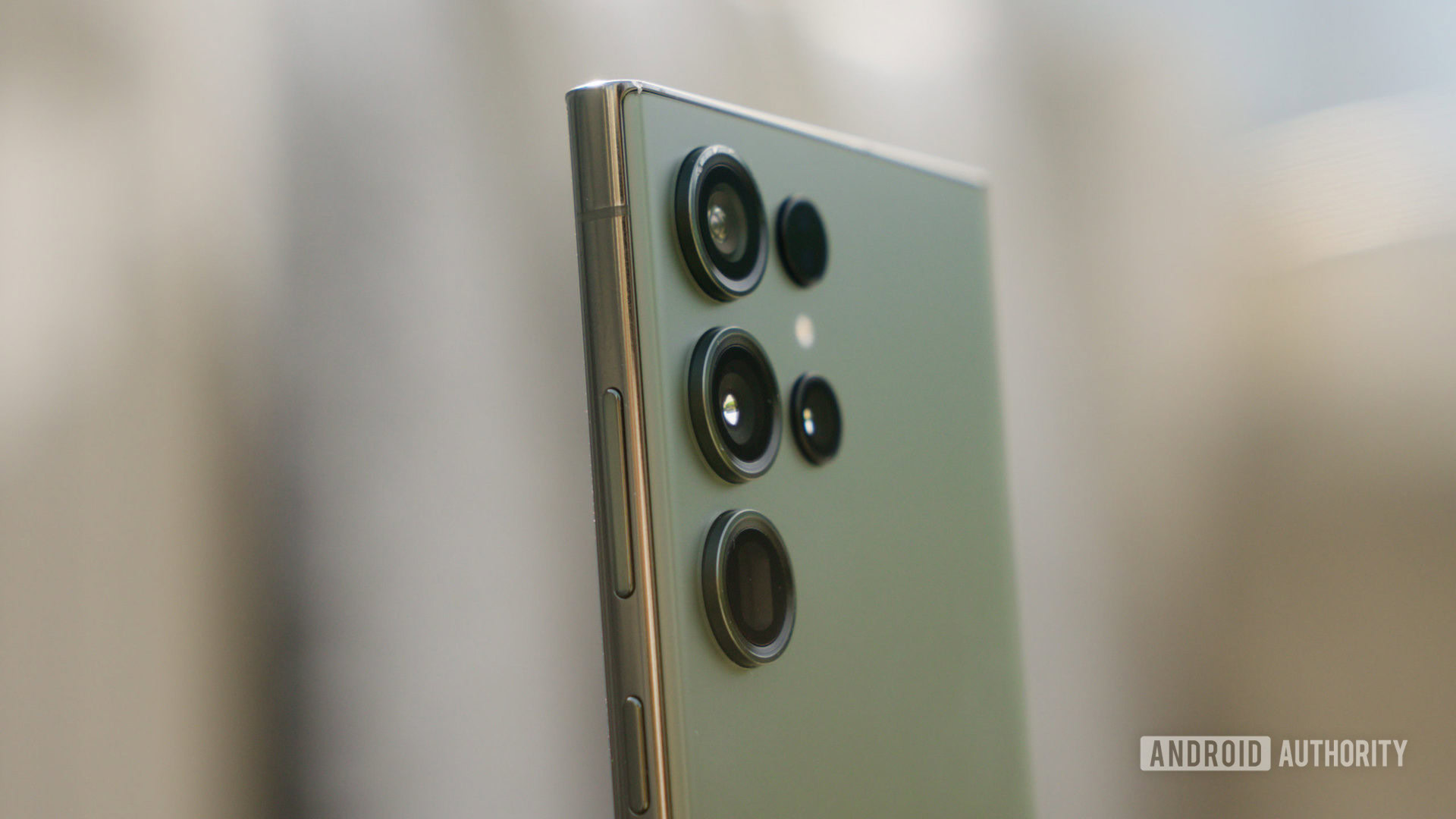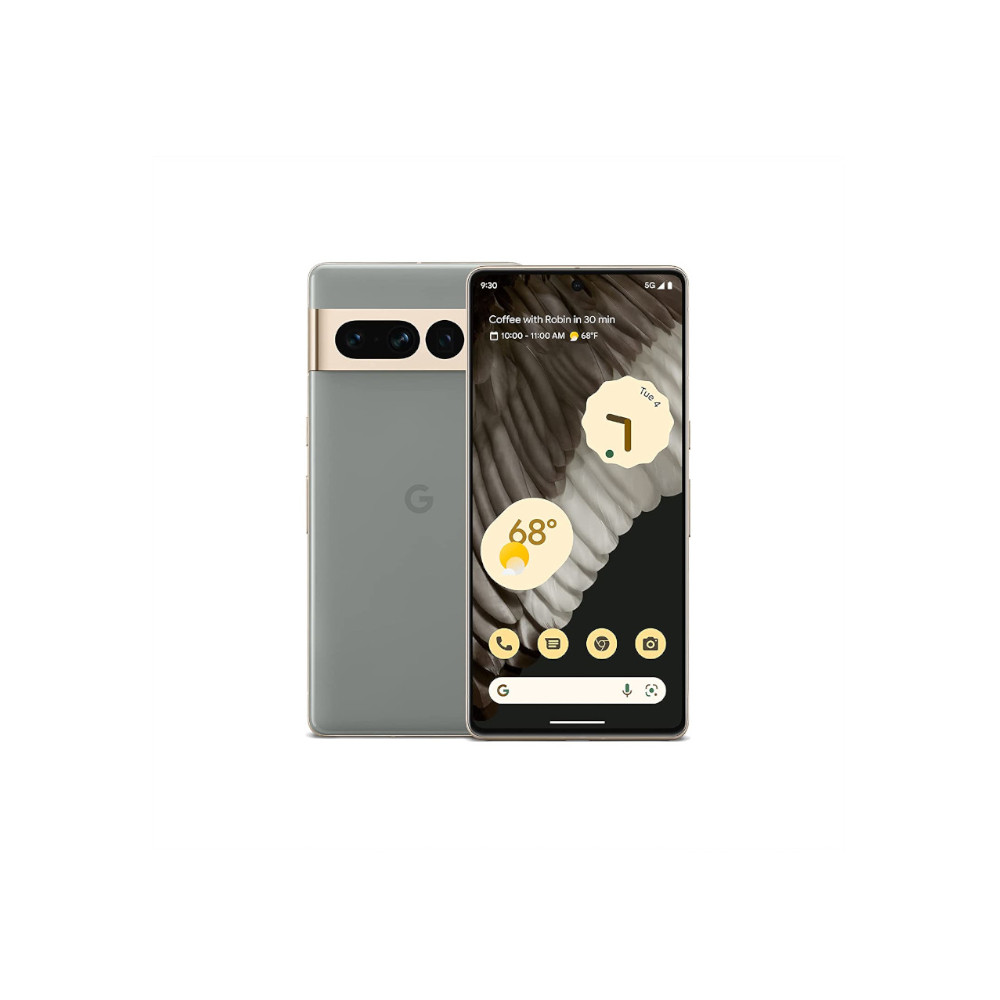Affiliate links on Android Authority may earn us a commission. Learn more.
Samsung Galaxy S23 Ultra camera shootout: Which phone claims #1?
April 1, 2023

The arrival of the Samsung Galaxy S23 Ultra presents mobile photography enthusiasts with yet another dilemma when picking out the best smartphone camera. In addition to the already impressive spec sheet, we’ve seen some minor improvements with the new 200MP and changes to how the phone handles zoom processing compared to its predecessor, but is that enough to surpass the competition?
To help decide, we’ve grabbed the mighty Apple iPhone 14 Pro Max and Google Pixel 7 Pro — your two top picks from late 2022 — to compare against Samsung’s finest. Let’s see what they all have to offer.
Samsung Galaxy S23 Ultra camera specs vs the competition
Before diving into the pictures, let’s recap what these phones bring to the camera hardware table. Samsung offers the most diverse array of hardware, sporting main, ultrawide, 3x, and 10x optical zoom capabilities. Apple and Google stick with a more classical triple-camera arrangement which, at least on paper, seems a bit less versatile.
Still, there are some similarities between these three photography powerhouses. Apple, Google, and Samsung have all embraced large, high-resolution, pixel-binning sensors for their main cameras. However, Samsung takes this to the extreme with its 16:1 200MP sensor. Likewise, you’ll find lower-resolution ultrawide and selfie snappers across the board. The table below offers a closer look at the specifics.
| Samsung Galaxy S23 Ultra | Apple iPhone 14 Pro Max | Google Pixel 7 Pro | |
|---|---|---|---|
Main Camera | Samsung Galaxy S23 Ultra 200MP (12.5MP 16:1 binning) ƒ/1.7 aperture 1/1.3" sensor Multi-directional PDAF, OIS | Apple iPhone 14 Pro Max 48MP (12MP 4:1 binning) ƒ/1.8 aperture 1/1.28" sensor Dual Pixel PDAF, sensor-shift OIS | Google Pixel 7 Pro 50MP (12.5MP 4:1 binning) ƒ/1.9 aperture 1/1.31" sensor Multi-directional PDAF, OIS |
Ultrawide | Samsung Galaxy S23 Ultra 12MP ƒ/2.2 aperture 1/2.55" sensor Dual Pixel PDAF | Apple iPhone 14 Pro Max 12MP ƒ/2.2 aperture 1/2.55" sensor Dual pixel PDAF | Google Pixel 7 Pro 12MP ƒ/2.8 aperture 1/2.9" sensor |
First zoom | Samsung Galaxy S23 Ultra 10MP ƒ/2.4 aperture 1/3.52" sensor Dual Pixel PDAF, OIS 3x optical zoom | Apple iPhone 14 Pro Max 12MP ƒ/2.8 aperture 1/3.5" sensor PDAF, OIS 3x optical zoom | Google Pixel 7 Pro 48MP (12MP 4:1 binning) ƒ/3.5 aperture 1/2.55" sensor PDAF, OIS 5x optical zoom |
Second zoom | Samsung Galaxy S23 Ultra 10MP ƒ/4.9 aperture 1/3.52" sensor Dual Pixel PDAF, OIS 10x optical zoom | Apple iPhone 14 Pro Max N/A | Google Pixel 7 Pro N/A |
Focusing | Samsung Galaxy S23 Ultra Laser AF | Apple iPhone 14 Pro Max 3D ToF Lidar | Google Pixel 7 Pro Laser AF |
Selfie | Samsung Galaxy S23 Ultra 12MP ƒ/2.2 aperture Dual pixel PDAF | Apple iPhone 14 Pro Max 12MP ƒ/1.9 aperture PDAF | Google Pixel 7 Pro 10.8MP ƒ/2.2 aperture |
Hardware is just part of the picture, though; all three handsets sport a selection of algorithmic and software capabilities to take photography up a level. Google continues to tout its impressive NightSight, Astrophotography, and Super Res Zoom technology. Samsung is improving its own Nightography feature, while Apple has doubled down on its Deep Fusion capabilities.
Time for some pictures. You can find the full-res snaps of all the pictures below (and more) in this Google Drive folder.
Samsung Galaxy S23 Ultra camera shootout

Colors and HDR
Color processing is, arguably, the most noticeable differentiator between smartphone cameras and the one that can instantly draw or repel consumers to and from a particular brand’s camera setup. It’s also the most subjective element of photography, so let’s proceed cautiously.
Instantly, we note substantial color pop with Samsung’s flagship, while the iPhone and Pixel are more reserved and natural. The fruit really jumps out of the scene below, but the excitable color pallet extends to the table as well. If you’re after a quick social share, this might suit you better, but the iPhone and Pixel are more realistic in the shots below.
The Galaxy S23 Ultra creeps back closer to those dreaded days of complete oversaturation. Thankfully, sky colors aren’t blown out of proportion, for example, and the saturation isn’t dialed up in every picture. The iPhone and Pixel have their own issues in the second shot above, this time with white balance. The iPhone is cooler but slightly yellow, while the Pixel is overly warm. Both are common themes you’ll spot throughout the snaps in this Galaxy S23 camera shootout.
Turning to some trickier HDR snaps, the Galaxy and Pixel are the more powerful of the trio, with the S23 Ultra nudging ahead in the trickiest environments. The iPhone 14 Pro Max presents us with a couple of underexposed subjects that no one should be happy with. This has been a constant issue with past iPhone models, which unfortunately hasn’t been addressed with the adoption of pixel-binning hardware.
There are telltale differences between the Pixel 7 Pro and Galaxy S23 Ultra. Google’s HDR algorithm is slightly more aggressive and scene-focused, almost to the point of pushing shadow exposure right up into the mid-tones. This looks a little flat to my eye. Samsung does a better job prioritizing the subject exposure, particularly in the second shot, even if it involves some highlight clipping. That 16:1 binning 200MP camera makes a fair bit of difference.
Even with just a handful of snaps under our belt, we can see a few pros and cons for each handset shaping up. The Pixel has the best colors but a slightly warm white balance. Apple aims for realism at the expense of HDR. Samsung is sometimes overly punchy but otherwise handles exposure the best.
A closer look at fine details
Despite resolutions spanning 48MP to 200MP, these three phones all output 12MP snaps by default. Let’s take a closer look at this default shooting mode to see if these unique sensors make any difference for fine detail capture. The snaps below are all 100% crops.
Unfortunately for the Galaxy S23 Ultra, there’s an excruciating level of over-sharpening applied in a number of snaps. While this does give the images more pop, close inspection reveals overly hard lines and jagged, aliased appearing edges. Not what you expect from a clean, Hi-Res image.
The iPhone 14 Pro is similarly problematic, with unsightly sharpening halos found around object edges in a bid to make up for slightly more smudged fine details than its rivals. Apple’s best just isn’t quite as detailed as its rivals. Google’s Pixel 7 Pro is better all around. While there’s a clear sharpening pass also, it avoids the worst of the artifacts while providing compatible, if not better, levels of detail in bright light.
Turning down the lights extends Google’s lead. Not only does the Pixel 7 Pro present the lowest level of noise, but you can pick out slightly different colors in the lights too. It’s a minuscule detail but harkens back to the phone’s more powerful HDR capabilities. At full-frame, the image perhaps looks a little flat, though.
The Galaxy S23 Ultra is noisy, grainy, and oversharp, but it captures the most texture detail on the leftmost building. At full frame, the added exposure and solid white balance might look best overall, but it’s not great in terms of detail. Apple’s iPhone is underexposed compared to the other two and still has sharpening artifacts, but you can see some texture detail hidden in the darkened areas.
Of course, turning to the Galaxy S23 Ultra’s 200MP mode will produce more detail than its rivals in very brightly lit environments. But you do sacrifice HDR and low noise capabilities, and the sensor doesn’t seem to make enough of a positive difference at 12MP.
Ultrawide
There are a few things to keep in mind when assessing the quality of a great ultrawide camera. For starters, a wide field of view with minimal distortion is a must, but we’re also eager to see equivalent dynamic range and colors when compared to the primary camera.
Starting with the Galaxy S23 Ultra, the ultrawide provides a decent step back from the already very wide main sensor. I don’t think you really need two wide perspectives like this, but that’s my preference. Perhaps the most noticeable positive here is that the two lenses have almost perfect color matching, even if it is rather punchy on both.
Samsung’s ultrawide boasts solid dynamic range, capturing a similar level of shadow and highlight detail as the main lens. Closer inspection reveals some noise and smudging issues in the shadows, oversharpening, and a small amount of chromatic aberration in the right-most trees. Not perfect, then, but a reasonably solid and consistent effort.
Turning to the iPhone 14 Pro, there’s an equivalent field-of-view, but the ultrawide appears to take a further step back, owing to the main lens’ slightly narrow field of view. It’s a similarly dark and gloomy picture on both lenses, owing to the phone’s more muted colors and weaker dynamic range. Slight variations are to be expected, but the iPhone de-emphasizes the cool blue tones a little too much between lenses.
Still, there’s very little sign of chromatic aberration and a reasonable level of detail, even in the shadows. Again though, there’s a lot of image cleanup and sharpening here when looking closely. Still, if it wasn’t for the all-around muted presentation here, this looks like a quite capable ultrawide shooter.
Google’s Pixel 7 Pro is a bigger offender regarding color grading inconsistency. The cooler white balance of the 1x shot gives way to warmer, more neutral hues on the ultrawide. The distant building, for example, is a completely different shade when switching lenses. However, it’s probably the main sensor that got the white balance wrong here.
Worse, there’s a clear lack of detail when cropping in. Shadows are very noisy, leading to mushy textures and a general lack of sharpness. To the Pixel’s credit, there is no sign of chromatic aberration on the right-most tree.
The ultrawide comparison below reinforces these general themes. You’ll receive a much more muted look from the iPhone 14 Pro Max. Its ultrawide is the cleanest in terms of detail, but oversharpening makes it far from faultless, even in broad daylight.
The Galaxy S23 Ultra and Pixel 7 Pro ultrawide snaps are comparatively messy, particularly at the frame edges but also in the center of the shot. Samsung offers by far the most color pop (it’s overkill here), with the Pixel sitting between the Galaxy and iPhone. I can’t say I really love any of these ultrawide cameras, but, as I have to pick, I’d take the iPhone to fix up in post.
Zooming in
With three different lens setups on offer, we’ve tested how each stacks up at 3x, 5x, and 10x zoom levels.
Google’s lens-merging Super Res Zoom continues to produce interesting results at 3x. The detail in the center of the frame is incredibly sharp, and every bit as good as you’ll find from the dedicated 3x optics on the iPhone and Galaxy. That said, there’s a noticeable degradation in image quality in the outer third of the frame, as the phone is relying on data to work with. The color balance is also slightly off, possibly due to white balance data carried between multiple lenses. The result is good but not as consistently crisp as the dedicated lenses on the other two phones.
Samsung’s 3x result is a little noisier than we might expect from a daylight shot, and does reduce the level of detail on offer. Generally, the white balance, color reproduction, exposure, and dynamic range are very robust here. The same can’t be said for the iPhone, which has washed out the brightly lit scene, perhaps owing to the almost-direct sunlight. It’s a shame because the details are otherwise solid.
Unfortunately for the iPhone, the situation doesn’t improve at 5x, at least not in terms of contrast and white balance. The details hold up surprisingly well, though, given it’s relying on 3x optical hardware. Apple’s software zoom implementation is becoming increasingly proficient. We can almost invert our analysis for the Galaxy S23 Ultra. Details turn mushy at 5x, as it’s caught out between its 3x and 10x zoom hardware, and there’s an overreliance on sharpening to add pop to the picture. That said, the phone continues to hand in good results when looking at colors, exposure, and white balance.
Google’s Pixel 7 Pro is the winner at 5x when it comes to detail, owing to its dedicated 5x camera. However, the iPhone isn’t far behind; Apple’s Deep Fusion algorithm continues to improve at a pace. The overall image is a little heavy on the contrast, making it look a tad under-exposed compared to its rival. It’s still a good image, though, even if this particular example doesn’t quite capture the scene’s brightness correctly.
The Pixel 7 Pro looks virtually as good at 10x as it crops data directly from the 48MP sensor for a “lossless” 10X zoom. The smaller pixels do result in more noise and a loss of detail, though (see the faces, for example), so it’s not quite equivalent to a really good 10x zoom. The phone has done a better job at color capture and exposure this time around, producing a very pleasing image overall. The iPhone continues to struggle with the glare of the sun in this instance, which again is disappointing because the level of detail appears to be surprisingly passable once again. But it’s certainly not quite up to the level of its rivals.
Samsung’s 10x hardware comes out ahead of its rivals, as we’d expect, providing a superior level of detail along with robust colors and exposure. It’s only marginally sharper than the competition, though, showing that the latest software-based zoom techniques are closing the gap on optical hardware.
Before drawing any conclusions, let’s double-check our analysis with more snaps.
Again, the iPhone seems to struggle the most in obtaining the correct exposure, over-brightening the 3x shot and under-exposing the subject in our 10x comparison. Color saturation and accuracy suffer as a result, which is disappointing because even the 10x shot would be otherwise just about passable, despite only featuring a 3x telephoto camera. Google’s 3x result continues to be mixed, again showing a muted exposure, iffy color balance, and varying sharpness across the image. Its 10x result is more impressive, with excellent exposure and colors, and only a smidgen less detail than the Ultra’s dedicated 10x camera. Samsung’s 10x shot is the pick of the pack, but it’s not flawless; the heavy sharpening pass and noise cleanup drop a few marks. Samsung’s 3x snap exacerbates the problem. It’s the most vivid but lacks the detail we’d expect from a 3x lens. Its competitors are arguably better in that regard.
Night modes
What’s instantly clear from the snaps below is that the Galaxy S23 Ultra is the more capable performer in low light without the aid of night mode. The large, modern image sensor clearly pays dividends when the lights go down. Exposure, colors, and dynamic range are all decent, while night mode mostly improves the noise level and detail. If anything, the dynamic range is flattened when turning night mode on.
The Pixel 7 Pro and particularly the iPhone 14 Pro Max struggle more for exposure and color balance when shooting with the default mode. Google’s night mode produces a result comparable to Samsung’s, albeit with subtle differences in sharpness and detail. Apple is still a step behind the competition. Although its night shot is a clear improvement, it lacks the color capture and fine detail of its rivals.
But what about the ultrawide and telephoto capabilities in low light? A solid camera array should perform equally well across all lenses regarding color capture, dynamic range, and exposure. All the shots below are captured without the aid of night mode.
Samsung’s Nightography extends its robust capabilities across lenses. There’s some noise in all three snaps, particularly the ultrawide, but it’s an acceptable level here. The S23 Ultra offers quite consistent colors, exposure, and dynamic range across all three lenses, though the lighting looks a little different on the ultrawide lens.
The iPhone 14 Pro Max is equally, if not even more, consistent. Colors are a match, whichever lens you pick. There’s a little less noise than the S23 Ultra, except for the ultrawide, which is not particularly clean. Still, all the lenses hold up better in dim lighting than in very dark conditions.
Lastly, the Pixel 7 Pro is less consistent than the other two. Without the aid of night mode, its images are a little more washed out, and we can also spot that the green Tetris block isn’t quite right either. It looks bluer on the main camera than the ultrawide. Again, Google’s ultrawide camera is noisier than the competitors and doesn’t look great on close inspection. Impressively, Super Res Zoom at 3x holds up well, with minimal noise and decent levels of detail. It’s just a tad underexposed.
All three are capable low-light shooters, then, but there’s a familiar assortment of pros and cons. The iPhone struggles the most in very dark conditions with more limited night mode capabilities, but handles dim light well across all three lenses. The Pixel 7 Pro’s main camera and night modes are solid, but the ultrawide and color accuracy are its weak links. The Galaxy S23 Ultra is the most consistent across conditions and lenses but can be noisy.
Portraits and selfies
Let’s turn to some portraits and selfies to round out our Galaxy S23 Ultra camera shootout.
As before, the Galaxy S23 Ultra offers far more punch in its pictures, but this high contrast look isn’t the most pleasing for facial features, while the color oversaturation pushes skin tones to slightly unrealistic levels. The iPhone leans the other way, with a cooler pallet and lower contrast that looks softer but isn’t strictly accurate either. The Pixel lands the best balance in terms of tone but has the roughest looking skin textures and harshes edges to its bokeh blur.
Using portrait mode to capture objects produced more mixed results. The S23 Ultra offers reliable edge detection and bokeh but completely underexposed the subject, unlike the iPhone, which is the best of the trio. The Pixel struggled with background detection here, blurring some trees more than others. The picture is otherwise fine, but the bokeh is a mess.
It’s a similar affair with selfies, both indoors and outdoors. Samsung’s high contrast look adds too much pop in the bright outdoor shot, but skin textures and bokeh are good in both. Apple’s selfies offer generally more realistic skin textures and are passable, if not slightly muted in terms of exposure and color. But there are issues with edge detection and noise in lower light.
Selfies from the Pixel 7 Pro look best outdoors; the indoor shot has an overly warm white balance. You can spot it in the outdoor shot too, but it’s more pronounced in limited lighting, which is a bit of a theme throughout this shootout. This issue aside, skin tones look about right, and the outdoor exposure is the best of the three, but the selfie snapper lacks finer details.
And the winner is…

Google’s Pixel 7 Pro has built a reputation on consistent photography, but this shootout has shown that Samsung’s Galaxy S23 Ultra should probably pinch that title. Whether you’re shooting in HDR, low light, across zoom levels, or snapping selfies, the Galaxy S23 Ultra takes the most consistent images in this shootout.
The problem is that the S23 Ultra hands in consistent issues too. A return to oversharp, oversaturated images takes the shine off what would probably otherwise be the best smartphone camera package money can buy. The 3x camera and 5x snaps are also starting to show their age against the competition’s more innovative approaches to zoom.
Which phone takes the better pictures?
Apple and Google scored a few wins, though. The iPhone 14 Pro Max does surprisingly well in the zoom and selfie tests, but its biggest weakness continues to be strong HDR lighting and nighttime photography. The Pixel 7 Pro is certainly superior in those regards and goes toe to toe with Samsung’s quad-camera array, thanks to impressive night and zoom software smarts. Unfortunately, white balance issues across lenses and rough portrait details let the phone down.
Still, I’d recommend the Google Pixel 7 Pro as the best bang-for-buck photography experience. It costs $300-$400 less but takes snaps that are virtually as good and sometimes even better than these ultra-pricey competitors. If money is no object, the Galaxy S23 Ultra is worthwhile for its best-in-class long-range zoom and night capabilities, so long as you can live with Samsung’s hit-and-miss color pallet or plan to shoot in RAW.

Beautiful display
S Pen functionality

